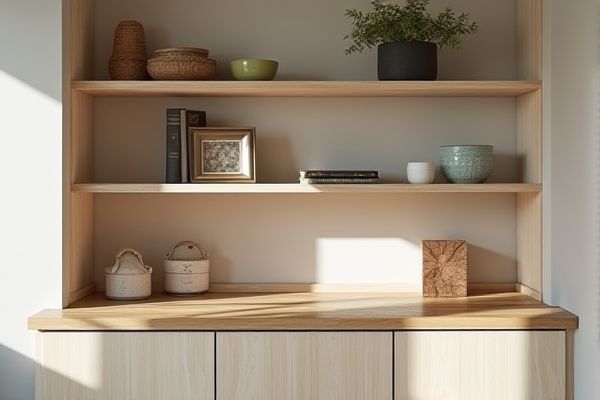
A drop-down shelf lowers from a vertical position to create a horizontal surface, offering easy access and space-saving benefits, while a fold-up shelf hinges upward against the wall, freeing floor space when not in use. To determine which shelf best suits Your needs and optimize your storage, explore the detailed comparison in the rest of this article.
Table of Comparison
| Feature | Drop-Down Shelf | Fold-Up Shelf |
|---|---|---|
| Design | Hinged panel drops down vertically | Shelf folds upward against the wall |
| Space Efficiency | Requires clear space below to drop | Requires space above to fold up |
| Installation | Simple hinge mechanism | Multiple hinges for folding action |
| Load Capacity | Moderate, depends on hinge strength | Moderate to high, supports heavier loads |
| Use Cases | Small kitchens, temporary workspace | Closets, compact living spaces |
| Accessibility | Easy to lower and access items | Quick to fold up and down |
| Durability | Depends on hinge and material quality | Generally robust with quality hinges |
Introduction to Drop-Down and Fold-Up Shelves
Drop-down shelves offer convenient horizontal surfaces that fold down from a vertical position, maximizing space while providing sturdy support for items. Fold-up shelves hinge upward and lock in place when not in use, making them ideal for compact areas where floor space is limited. Understanding the benefits of each type helps you choose the best shelf solution for your storage or workspace needs.
Key Design Differences
Drop-down shelves pivot downward from a fixed hinge, providing easy access by lowering the shelf surface, while fold-up shelves hinge upward, folding against the wall to save space when not in use. Drop-down shelves typically require more clearance in front for operation, whereas fold-up shelves demand vertical clearance above the shelf area. Material choice and hinge type also differ, with drop-down shelves often using robust hinges for load-bearing support and fold-up shelves utilizing friction hinges or stays to maintain the folded position.
Space-Saving Capabilities
Drop-down shelves offer enhanced space-saving capabilities by folding vertically against the wall, freeing up floor space when not in use. Fold-up shelves provide similar benefits but typically fold horizontally, allowing compact storage in tight areas and easy accessibility. Both shelf types maximize room efficiency, with drop-down shelves ideal for narrow spaces and fold-up shelves suitable for versatile placement in small rooms or kitchens.
Installation Requirements
Drop-down shelves require sturdy wall framing for secure mounting due to their hinged design, ensuring stability when pulled down. Fold-up shelves typically need less reinforcement, as they fold against the wall and bear weight primarily when in use. Your choice depends on available wall support and desired ease of installation.
Material and Durability Comparison
Drop-down shelves are typically constructed from sturdy materials like solid wood or metal, offering high durability and long-lasting support for heavy items. Fold-up shelves often use lightweight metals or engineered wood composites, providing moderate strength but greater portability and space-saving benefits. Choosing the right option depends on your need for robust load-bearing capacity versus compact storage convenience.
Usability and Accessibility
Drop-down shelves offer easy access and a stable platform for frequently used items, making them highly usable in kitchens and workspaces where quick reach is essential. Fold-up shelves save space by collapsing against the wall when not in use, enhancing accessibility in small or narrow areas without permanent obstruction. Your choice depends on whether you prioritize continuous usability or maximizing open space for movement.
Aesthetic and Style Options
Drop-down shelves offer a sleek, minimalist look that seamlessly blends into walls when folded, making them ideal for modern, space-saving interiors. Fold-up shelves provide a more versatile aesthetic with visible hinges and support brackets, which can complement rustic or industrial decor styles. Your choice depends on whether you prioritize hidden storage for a clean appearance or a functional, decorative element that adds character to your space.
Cost and Maintenance Considerations
Drop-down shelves often have a lower initial cost due to simpler hardware and installation processes, making them budget-friendly for many homeowners. Fold-up shelves, while typically more expensive upfront because of their complex hinges and supports, may offer better long-term durability but require regular maintenance to ensure smooth operation and prevent wear. Maintenance costs for drop-down shelves tend to be minimal, involving occasional tightening of fixtures, whereas fold-up shelves may incur higher expenses over time due to the need for lubrication and hinge replacement.
Ideal Applications and Use Cases
Drop-down shelves excel in spaces requiring easy access and visibility, making them ideal for kitchens, closets, and retail displays where items need to be quickly grabbed or showcased. Fold-up shelves are perfect for small areas needing flexible storage, such as compact apartments, garages, or workshops, allowing you to maximize space by folding the shelf away when not in use. Your choice should align with the need for either constant accessibility or occasional, space-saving storage solutions.
Choosing the Right Shelf for Your Needs
Drop-down shelves offer sturdy, fixed storage ideal for heavier items, while fold-up shelves maximize space efficiency by collapsing when not in use. Your choice depends on whether you prioritize strength and accessibility or compactness and flexibility for your room. Selecting the right shelf hinges on balancing your storage requirements with available space and usage frequency.
 homyna.com
homyna.com